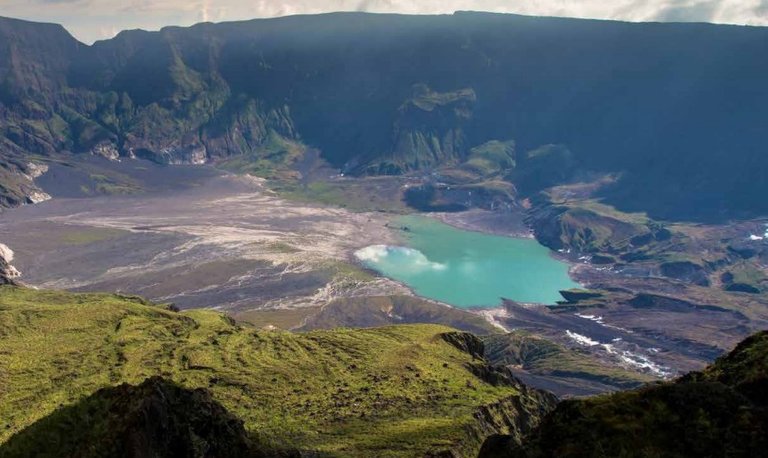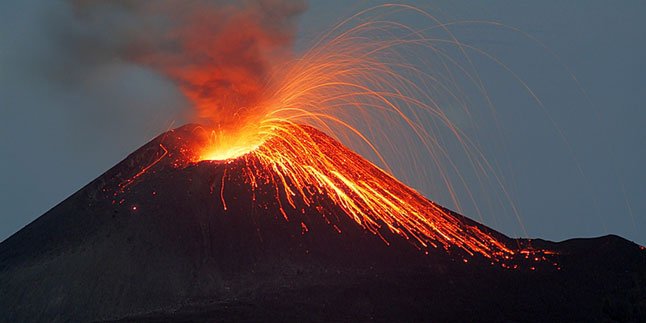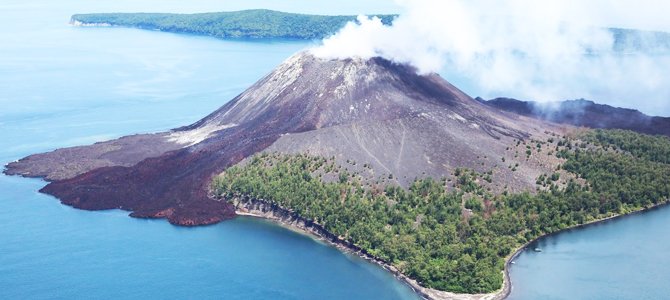for this time because the request of our friend with id steemit @xwerk I try to translate and re-share stories about the eruption of the mountain in the world and most of it in Indonesia.
1. MOUNTAIN TAMBORA
The first eruption of Mount Tambora was heard on 5 April 1815 in Java Island (Jakarta), heard for 15 minutes and lasted until the next day, like a cannon.
Thus the record of the Dutch East Indies Governor, Thomas Stamfford Raffles, about the eruption of Mount Tambora in his memoir The History of Java.
Raffles wrote the explosion was thought to be a cannon attacking troops in Yogyakarta. On April 6, closed sunlight and small amounts of ash rain began to blanket Sulawesi and Gresik in East Java.
Notes about the eruption of Mount Tambora are also listed on the ancient manuscripts of the Kingdom of Bima, Bo Sangaji Kai.
"Then the dark turns more than that night, then it sounds like the sound of a war cannon, then the rock and stone cascades down as long as poured for three days and two nights," said the ancient manuscript as read by the philologist Siti Maryam Salahuddin, 88 years old, who is the daughter of the last Sultan of Bima, Muhamad Salahuddin.
According to Lieutenant Owen Philips, as Raffles' envoy, King Sanggar is still alive and witnesses the event.
"Around 7 pm on April 10, three great fireballs emerged from Mount Tomboro. Then the three fireballs joined the air in a huge explosion, "said the King Sanggar.

Tambora's current mountain image

2. MOUNTAIN KRAKATAU
134 years ago, the Sunda Strait was hell. Krakatau Mountain, which sleeps for 200 years stretched. He did not just erupt, but blew himself up to pieces.

The climax took place Monday, August 27, 1883, exactly at 10.20, Krakatau erupts terrible. Its power is equivalent to 150 megatons of TNT, over 10,000 times the atomic bomb force that devastated Hiroshima and Nagasaki in Japan. Destroying the island and triggering two tsunamis, 40 meters high, killed more than 35,000 people. That's the official version.
A number of reports say, the victim reached 120 thousand. Human skeletons are found floating in the Indian Ocean to the east coast of Africa until one year after the eruption.
The sound of explosions and roar of the eruption of Krakatau sounded up to a radius of more than 4,600 km to be heard throughout the Indian Ocean, from Rodriguez Island and Sri Lanka in the west, to Australia in the east.
The eruption is still recorded as the loudest explosive sound ever heard on earth. Anyone within a 10 kilometer radius undoubtedly becomes deaf. The Guinness Book of Records recorded the sound of Krakatoa explosions as the most powerful sound recorded in history.
"As a result not only eliminates an island along with its people, but it stagnates centuries-old colonial economies," says Simon Winchester, author of Krakatoa: The Day the World Exploded, August 27, 1883.
The eruption of Krakatau also created the phenomenon of space. Through the volcanic ash. The ash that spurted into space, making the Moon blue.
After the eruption, Krakatau was completely destroyed. Starting in 1927 or approximately 40 years after the eruption of Mount Krakatoa, a volcano appears known as Anak Krakatau. He is very active and growing. Will he erupt like his mother? No one knows.
Anak Krakatau is one of 100 volcanoes that NASA continues to monitor through Earth Observing-1 or EO-1 satellites.
There are two reasons why NASA keeps watching the Anak Krakatau. In addition to constantly bererupsi, this is also motivated by historical factors.
Krakatau current mountain image

1. MOUNTAIN VESUVIUS POMPEI

Mount Vesuvio (Italian: Monte Vesuvio) is the only active volcano in the Mainland Europe located east of Naples, Italy. In the year 79, the eruption of this mountain destroyed the city of Pompeii.
Pompeii is an ancient Roman city that has become debris near the city of Naples and is now in the region of Campania, Italy. Pompeii was destroyed by the eruption of Mount Vesuvius in 79 AD [1] The volcanic eruption of Vesuvius piles the city of Pompeii with all its contents as deep as a few feet causing the city to disappear for 1,600 years before being rediscovered by accident. Since then the city's excavations provide an extraordinarily detailed view of the life of a city at the height of the glory of the Roman Empire. Currently the city of Pompeii is one of the UNESCO World Heritage Sites.
Mount Vesuvius is famous for the eruption in AD 79 that led to the destruction of the Roman cities of Pompeii and Herculaneum and the deaths of 10,000 to 25,000 people. This volcano has erupted several times and is currently considered one of the most dangerous volcanoes in the world because there are a population of 3,000,000 people living nearby and their tendency to stay towards explosive (Plinian) eruptions.
@xwerk if you need all about mount i shared all mount at indonesian hehehe
Wow, thank you for the effort. Great read, love it.
Following!
Great post. Thanks
Thanks for Comment Zainal, salam dari Aceh